|
|
|
| My Favourite Planet > English >
People > Ancient Greek artists> Potters/vase painters A-D |
| MFP People |
Ancient Greek artists – page 7 |
 |
Page 7 of 14 |
 |
|
| |
| Potters / vase painters A - D |
| |
|
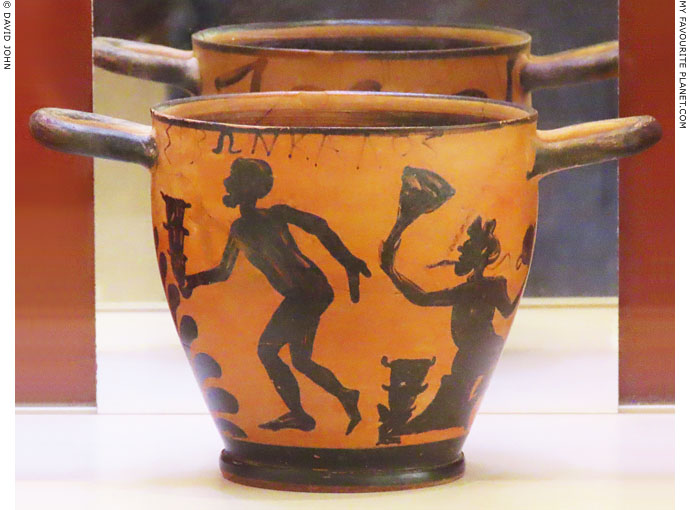
A Boeotian black-figure skyphos showing a scene from a
potter's workshop, in which a bad potter is being punished.
From Exarchos, Lokris, central Greece. Around 430 BC.
National Archaeological Museum, Athens.
Vase collection. Inv. No. 442. |
| |
Potters and
vase painters |
A |
|
|
| |
Amasis and the Amasis Painter
Ἄμασις
A potter and a vase painter of the black-figure style, working in Athens around 560-515 BC.
Amasis signed his name as potter (maker): Ἄμασις μέποίησεν (Amasis m'epoiesen, Amasis made me). Of the 12 or perhaps 13 vessels and fragments found so far with this signature 11 were decorated by the painter who has been named the Amasis Painter. No work signed by the artist as painter has yet been discovered.
Some scholars have considered the potter and painter to be the same person. However, this theory was challenged when in 1971 J. Frel attributed the painted decoration on a shoulder type lekythos signed by Amasis as potter to the Taleides Painter. J. Paul Getty Museum, Malibu. Inv. No. 76. AE.48. Height 23 cm.
Two vases thought to have been painted by Lydos have been attributed to Amasis as potter: a psykter-amphora in the British Museum, Vase No. B 148; a panel-amphora of type B in the Cabinet des Medailles, Paris.
Amasis was the Hellenized form of the common ancient Egyptian name Ahmosis (perhaps pronounced A-ames). It has thus been conjectured that he was born or had previously lived in Egypt, possibly from a Greek or mixed Greek-Egyptian family, perhaps living in Naukratis (a Greek trading post in the Nile Delta). Although he was born too early to have been named after Pharoah Ahmosis II, who ruled 569/568-526 BC (mentioned by Herodotus, particularly Book 2, chapter 161 onwards), his signature appears only on works from the middle - late periods of his career (after 550 BC), and he may have adopted Amasis as a tradename or nickname after he had established his reputation.
What is believed to be the earliest signature of Amasis, on a fragmentary band-cup, is dated around 550 BC. The painting is attributed to the Amasis Painter. J. Paul Getty Museum, Malibu. Inv. No. 79. AE.197.
A black-figure neck amphora, painted by Exekias, circa 540-535 BC. On Side A, Achilles killing the Amazon queen Penthesileia. On Side B, Memnon, bearded and fully armed, facing right, flanked by two black African attendants. Inscribed above one, behind (left of) Memnon's head, έπ]οίησ(ε)ν (?); above the other, in front of Memnon's head, AMAΣIΣ (Αμασις). Scholars remain uncertain whether the inscription is the signature of Amasis as potter, or Exekias making a humorous comment on his name or nickname, possible "dusky" appearance or foreign origin. Height 41.5 cm, width 30 cm, weight 3.6 kg. British Museum. Inv. No. GR 1849.5-18.10 (Vase B209).
The name AMAΣΟΣ (Amasos) also appears above a similar black African warrior being attacked by Menelaos on a fragmentary panel amphora painted by Exekias, circa 530 BC. University Museum, Philadelphia. Inv. No. MS 3442.
It has been suggested that Amasis may have introduced the alabastron (oil or perfume vessel), originally an Egyptian form, to Attica.
He is also thought to be the father of the potter Kleophrades whose siganture ΚΛΕΟΦΡΑΔΕΣ: ΕΠΟΙΕΣΕΝ: ΑΜΑΣΙΔΟΣ (Kleophrades made it, son of Amasis) apears on the profile of the foot of a fragmentary cup now in the J. Paul Getty Museum, Malibu. Inv. No. 83.AE.217. The inside of the cup is signed by Douris (ΔΟΡΙΣ, see below) as painter. Fragmentary signatures by Kleophrades as potter are also known from vases and fragments in other museums. As with the Amasis Painter, the Kleophrades Painter, around 115 of whose red-figure works have survived, has been associated with Kleophrades the potter.
The Amasis Painter is considered, along with Exekias and Lydos, one of the most important and influentual Attic black-figure artists, and like Lydos he was a prolific craftsman who had a long career.
He may have been a pupil of the Heidelberg Painter (working around 575-550 BC), since some of what are considered to be his early works are similar in style, although he was also influenced in style and subject matter by other painters such as Kleitias, Lydos and Nearchos.
Around 132 vases and fragments have been securely attributed to the Amasis Painter, with a number of others considered uncertain. Two have not been seen for over 150 years; others went missing, perhaps destroyed, during World War II. It is not known whether all the vases painted by him were made by the same potter.
His works were exported all around the Greek world, and have been found on the Greek mainland and islands, Thrace (Kavala), Cyprus, Egypt (Naukratis), Sicily, southern Italy, as well as Etruria, and even south Russia (Berezan).
He painted a wide variety of vessels, including panel and neck amphorae, oinochoai (wine jugs), lekythoi (oil jars) and cups, but not larger vases such as kraters or hydriae. His subjects included narrative mythological scenes, non-narrative depictions of gods (particularly Poseidon and Athena) and mortals, Dionysus and his thiasos (entourage) and several genre scenes.
An olpe (wine jug) with a depiction of Perseus decapitating Medusa, watched by Hermes. Found 1828/1829 in Vulci, Etruria, Italy, the first vase to be discovered with the signature of Amasis as potter, Aμασίς μ’ έποίησεν (Amasis m'epoiesen, Amasis made me). The painting was thus attributed to the Amasis Painter by John Beazley. British Museum, London. Inv. No. 1849,0620.5 (Vase B 471). Height 25.77 cm.
A skyphos from Rhodes, Dionysus and Ariadne with satyrs flanked by two youths (see photo below). Rhodes Archaeological Museum.
A shoulder type lekythos found in Kerameikos, Athens, with a depiction of wrestlers (see photo below). Kerameikos Archaeological Museum. Inv. No. 25829.
An olpe, circa 540 BC, with a depiction of Herakles entering Olympus with Athena and Hermes, greeted by Poseidon (rather than Zeus). Signed Ἄμασις μέποίησεν (Amasis m'epoiesen, Amasis made me). Height 26.4 cm, diameter 13.5 cm. Louvre Museum, Paris. Inv. No. F 30.
A cup from Vulci. Side A, a fight scene between warriors and horseman between palmettes and other devices, a cock, a star and a bee. Side B, with Dionysus and Ariadne, flanked by a Maenad and a Satyr. Louvre. Inv. No. F 75.
A neck amphora from Vulci. On Side A depiction of Athena and Poseidon. On Side B Dionysus and two Maenads (see image below). Signed Ἄμασις μέποίησεν (Amasis made me) on both sides. Shoulder, Sides A and B, battle scene. Height 33 cm. Cabinet des Médailles, Paris. Inv. No. 222.
A lekythos from Vari, with women weaving. Height 17.2 cm. Metropolitan Museum, New York. Inv. No. 31.11.10.
A lekythos with a wedding procession. Height 17.1 cm. Metropolitan Museum, New York. Inv. No. 56.11.1.
A fragment of a black-figure amphora, around 540-530 BC, with a depiction of the lower part of a draped male with a spear or trident, and part of a leg with a greave. Signed Ἄμασις μέποίησεν. Metropolitan Museum, New York. Inv. No. 1985.11.2.
A fragment of a black-figure amphora, around 540-530 BC, with a depiction of the lower part of a draped male with a spear or trident, and part of a leg with a greave. Signed Ἄμασις μέποίησεν. Metropolitan Museum, New York. Inv. No. 1985.11.2.
An alabastron from the Athens Agora, with a female winged deity, perhaps Nike, between youths. Height 9.2 cm. Agora Museum, Athens. Inv. No. P 12628.
A fragmentary neck amphora from Orvieto. On Side A Poseidon(?) and Athena. On Side B two warriors. Under each handle Dionysus, looking back. Signed Ἄμασις μέποίησεν on both sides. Museum of Fine Arts, Boston. Inv. No. 01.8026.
A neck amphora from Orvieto. On Side A Apollo and Herakles struggling for the Delphic Tripod, signed Ἄμασις μέποίησεν. On Side B Achilles receiving from Thetis the armour made by Hephaistos. Museum of Fine Arts, Boston. Inv. No. 01.8027.
A kylix, on one side with two Satyrs masturbating, and on the other a Siren with a body in the form of a large eye. Museum of Fine Arts, Boston. Inv. No. 10.651.
A fragmentary black-figure eye cup. Inside, a Gorgoneion. Between the eyes: Side A a bearded komast; Side B a woman (hetaera) holding a lyre. Signed Ἄμασις μέποίησεν on both sides. Vatican Museums, rome. Inv. No. 369a.+.
A cup from Vulci, with horses and grooms in the divine stables. Schimmel Collection, Kings Point.
A belly amphora with Menelaos recovering Helen. Private collection, UK.
In 1985 the Amasis Painter was given the first "one man show" - or exhibition of works by a single artist - ever organized for an ancient Greek vase painter. 65 of his 132 known surviving works were brought together from museums and collections around the world. The exhibition was curated by Dr. Dietrich von Bothmer, at the time Chairman of the Department of Greek and Roman Art at the Metropolitan Museum of Art, who proposed that it should open on 13th September 1985, the centenary of the birth of the art historian Sir John Beazley (1885-1970).
After its run in the Metropolitan Museum of Art, New York, 13 September - 27 October 1985, the exhibition moved to the Toledo Museum of Art, Ohio, 24 November 24 - 5 January 1986, then the Los Angeles County Museum of Art, 20 February - 6 April 1986.
The exhibition catalogue: Dietrich von Bothmer, The Amasis Painter and his world: Vase-painting in sixth-century B.C. Athens. Co-published by J. Paul Getty Museum, Malibu, California and Thames and Hudson, New York / London, 1985. Free PDF at Getty Publications Virtual Library.
Also, the companion volume to the exhibition catalogue: Papers on the Amasis Painter and his world. Colloquium sponsored by the Getty Center for the History of Art and the Humanities and symposium sponsored by the J. Paul Getty Museum, 28 February - 2 March 1986. J. Paul Getty Museum, Malibu, California, 1987. Free PDF at Getty Publications Virtual Library. |
|
|
| |
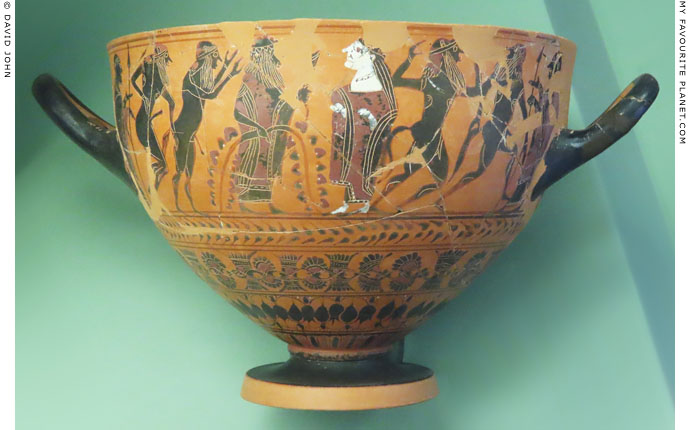
The side of an Attic black-figure skyphos attributed to the Amasis Painter.
Bearded Dionysus, holding ivy branches, and Ariadne stand facing each
other, with two naked satyrs on either side. The whole group flanked by
two draped men holding spears.
From an inhumation burial, Marmaro T 10. 550-520 BC. Found in 1934
during excavations in the Archaic cemetery at Marmaro, near the
ancient city of Ialysos, northwestern Rhodes.
Rhodes Archaeological Museum. |
| |
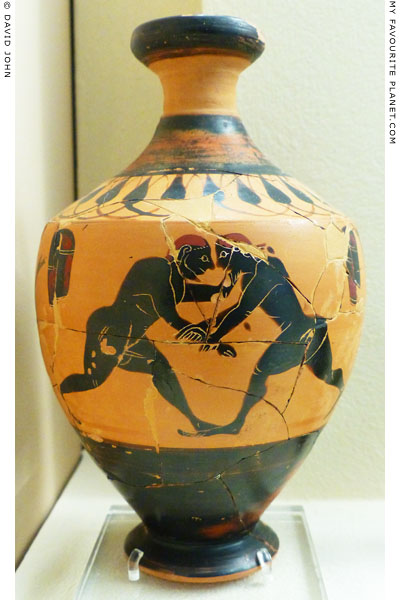
An Athenian black-figure shoulder type lekythos
with a depiction of two athletes wrestling between
draped men. Their garments hang behind them.
Attributed to the Amasis Painter, around 550-525 BC.
From the Kerameikos (T 243/VII), Athens.
Kerameikos Archaeological Museum. Inv. No. 25829.
The poses of the two figures and their wrestling holds are identical to those on
the neck of Side B of a panel neck-amphora, attributed to the Amasis Painter,
now in the Antikenmueum und Sammlung Ludwig, Basel. Inv. No. BS 497. |
| |
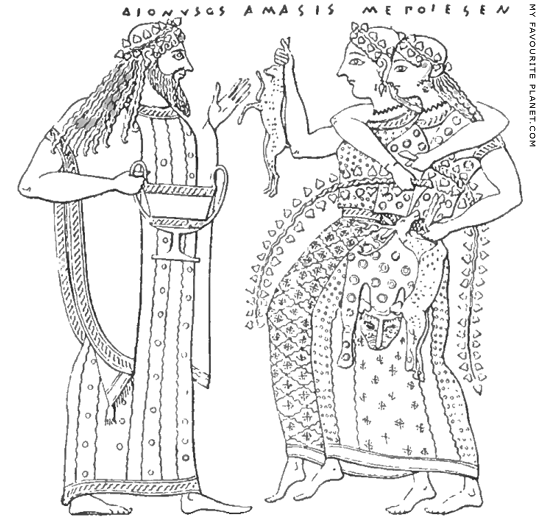
Dionysus and two dancing Maenads holding animals and ivy branches,
on an Athenian black-figure neck amphora, signed by Amasis on both
sides. Inscribed on this side (Side B) above the figures:
Διόνυσος Ἄμασις μέποίησεν.
Dionysus Amasis made me.
On Side A is a depiction of Athena and Poseidon.
On the shoulder, Sides A and B, battle scene.
From Vulci. Height 33 cm.
Cabinet des Médailles, Paris. Inv. No. 222.
Image source: Wilhelm Heinrich Roscher (editor), Ausführliches Lexikon der
griechischen und römischen Mythologie, Zweiter Band, Zweite Abteilung,
column 2259. B. G. Teubner, Leipzig, 1894. At the Internet Archive. |
| |
Andokides Painter
Red-figure vase painter, working in Athens around 530-500 BC.
He was named by John Beazley after the potter Andokides (Ἀνδοκίδης), whose signature is on five vases with paintings attributed to this artist.
He is thought to have been a pupil of Exekias, and with Psiax is among those credited with the invention of the red-figure painting technique around 530 BC. He may have also invented the white ground technique.
Paintings on 14 amphorae and 2 cups are attributed to the Andokides Painter, of which 6 belly amphorae and one cup are "bilingual", i.e. painted with both red-figure and black-figure scenes.
The question of whether the paintings were by one or two artists has been long debated. John Beazley attributed the black-figure scenes to a separate artist he named the Lysippides Painter. On the other hand, John Boardman later wrote, "So the Andokides Painter did paint black figure and it is difficult to escape the conclusion that he and the Lysippides Painter are one and the same." (John Boardman, Athenian black figure vases, page 105. Thames and Hudson, London, 1974 [reprint, 1997].) More recent studies of drawing styles and techniques suggest that the paintings are by two separate personalities.
Attributed works signed by Andokides as potter:
Red-figure belly amphora, circa 525 BC. Side A, Herakles and Apollo struggle for the Delphic tripod. Side B, wrestlers. H. 58.2 cm. Berlin State Museums (SMB). Inv. No. F 2159.
Red-figure belly amphora with black-figure painting on the lip, attributed to Psiax. Side A, Herakles and Apollo struggle for the Delphic tripod. Side B, Dionysus between Maenad and Satyr. Metropolitan Museum, New York. Inv. No. 63.11.6.
Red-figure belly amphora, circa 530-520 BC. Side A, Amazons; Side B, Bathing women. Height 40.5 cm. Louvre, Paris. Inv. No. F 203.
Belly amphora, circa 525-520 BC. Side A, warriors fighting between Athena and Hermes. Side B, youth with kithara. Height 57.2 cm. Louvre, Paris. Inv. No. G 1.
Bilingual eye cup, with the Lysippides Painter. Warriors and archers. Antonino Salinas Regional Archaeological Museum, Palermo, Sicily. Inv. No. V 650 (2051).
Attributed bilingual vases with the Lysippides Painter include:
Bilingual belly amphora, circa 520-500 BC. Side A, black-figure, Achilles and Ajax playing a board game. Side B, red-figure, Herakles fighting the Nemean Lion (see photo below). Height 54.6 cm. British Museum. GR 1839.11-9.2 (Vase B 193).
Bilingual neck amphora, circa 520-500 BC. Side A, black-figure, Achilles and Ajax playing a board game (see Homer part 2). Side B, red-figure, Herakles fighting the Nemean Lion. British Museum. GR 1851.8-6.15 (Vase B 211).
Bilingual belly amphora. Side A, black-figure, Herakles and the Nemean Lion. Side B, red-figure, Dionysus and Maenad between Satyrs. Museo Civico, Bologna. Inv. No. 151.
Bilingual belly amphora, circa 520-510 BC. Side A, black-figure, Herakles feasting. Side B, red-figure, Herakles feasting. Height 53.5 cm. Staatliche Antikensammlungen, Munich. Inv. No. 2301.
Bilingual belly amphora, circa 530-520 BC. Side A, red-figure, Herakles and Kerberos. Side B, black-figure, Dionysos with kantharos between Maenads and Satyrs. Height 58.2 cm. Louvre, Paris. Inv. No. F 204.
Bilingual belly amphora. Side A and Side B, Achilles and Ajax playing a board game. Museum of Fine Arts, Boston. Inv. No. 01.8037.
Bilingual belly amphora. Side A and Side B, Herakles and the Cretan Bull. Museum of Fine Arts, Boston. Inv. No. 99.538. |
|
|
| |
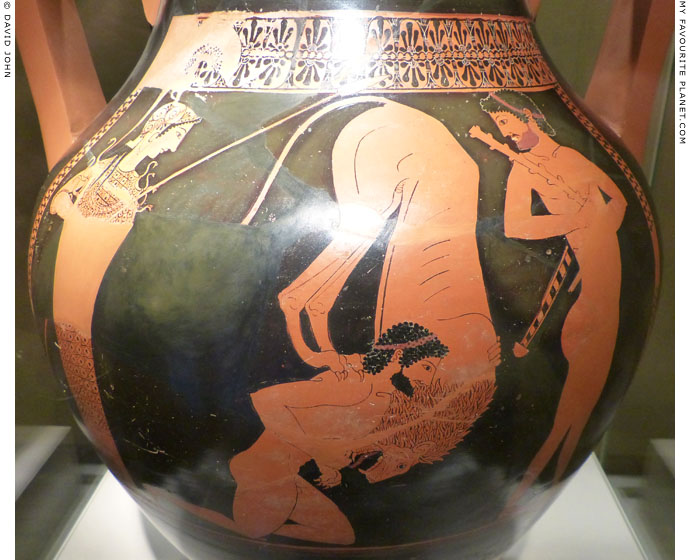
Herakles fighting the Nemean Lion, watched by Athena (left) and Ioalaos (right).
Detail of a "bilingual" belly amphora made in Athens about 520-500 BC. This red-figure
painting is attributed to the Andokides Painter. On the other side of the vase (Side A)
is a black-figure scene of Achilles and Ajax playing a board game (see Homer part 2)
attributed to the Lysippides Painter. Height of amphora 54.6 cm.
British Museum. GR 1839.11-9.2 (Vase B 193). |
| |
Antimenes Painter
Black-figure vase painter in Athens, active around 530-510 BC.
His black-figure work is stylistically close to that of Psiax, who worked for the same workshop.
He is named after a kalos inscription, "Antimenes kalos", on a hydria (ὑδρία, water-carrying vessel with three handles) in the Rijksmuseum van Oudheden, Leiden. Inv. No. PC 63.
An Attic black-figure neck amphora, around 520 BC, attributed to the Antimenes Painter: Side A, Dionysus mask between two large eyes; Side B, a similar mask of a satyr between two large eyes. Berlin State Museums (SMB). Inv. No. F 3997.
A large fragmentary Attic black-figure dinos, late 6th century BC, attributed to the Antimenes Painter. Found in the Heraion at the mouth of the river Sele, Paestum, southern Italy. Paestum Archaeological Museum.
An Attic black-figure calyx-krater, around 510 BC, found in an Archaic necropolis in Syracuse, Sicily, is decorated with paintings attributed to an artist related to the Antimenes Painter. On Side A Herakles and Athena in a chariot surrounded by other deities, and on Side B Dionysus with Satyrs and Maenads (see Dionysus). Paolo Orsi Regional Archaeological Museum, Syracuse, Sicily. Inv. No. 50960. |
|
|
| |
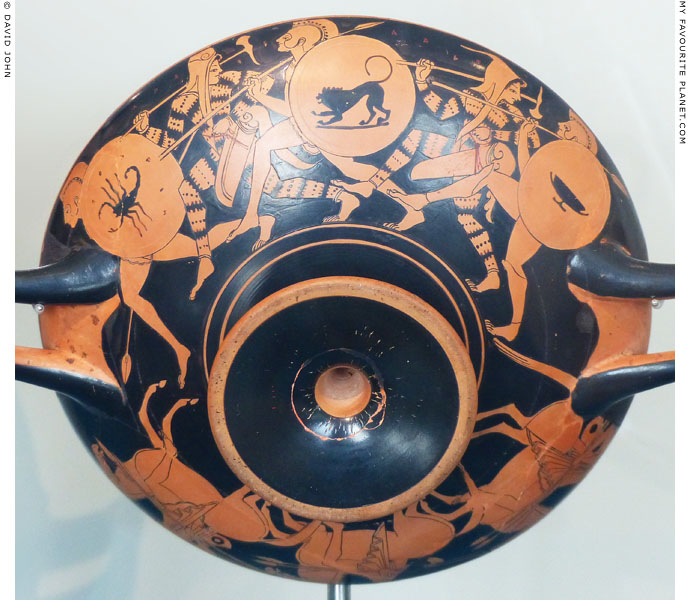
Detail of the outside (underside) of an Attic red-figure kylix painted by Apollodoros.
End of the 6th century BC.
Museum für Kunst und Gewerbe Hamburg. Inv. No. 1983.277. Gift of Herbert Joost, Hamburg. |
| |
Aristonothos
Ἀριστόνοθος (the name means Noble Bastard)
Vase painter and/or potter of the Late Geometric style, perhaps from Euboea, active around the mid 7th century BC.
The earliest known potter and/or painter.
"The Aristonothos Krater" (see images below) is the only vase so far attributed to Aristonothos. The Late Geometric krater, found in the 19th century in a tomb at the Etruscan city Caere (today Cerveteri), has been dated variously to around 680-630 BC.
One side is decorated with a depiction of Odysseus blinding Polyphemos, and is inscribed with the earliest signature by a Greek painter or potter Ἀριστόνοθος ἐποίσεν (Aristonothos epoiesen, Aristonothos made it), thought to be written in the Ionic script of Euboea, although readings of the inscription differ. It is not known whether the signature refers to the potter or painter, nor whether the krater was produced in Greece or Italy. The name has also been interpreted as Aristonophos, Aristonoos and Ariston of Kos. The signature turns 90 degrees from horizontal to vertical in the middle, after Ἀριστόνο (Aristono), making it difficult to tell whether the next letter is meant to be Θ (theta) on its side, or Φ (phi, which would make the name Aristonophos). Since ἐποίεσεν (epoiesen) has been mispelled, it has been suggested that the artist, or whoever wrote the signature, was not used to the recently developed art of writing in the Greek alphabet.
The other side of the krater shows warriors on two ships in a sea battle. Height 36 cm, maximum diameter 40 cm. Palazzo dei Conservatori, Capitoline Museums, Rome. Inv. No. 172. From the Castellani Collection. |
|
|
| |
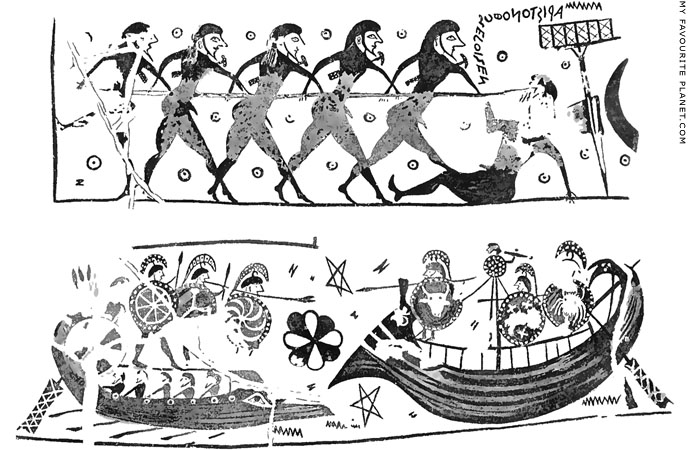
Drawings of the paintings on the "Aristonothos Krater".
Side A (top): Odysseus and four of his men blind the Cyclops Polyphemos by
thrusting a long wooden stake in to his eye. For details see Homer part 3.
In the top right is the signature of Aristonothos, written retrograde:
Ἀριστόνοθος ἐποίσεν (Aristonothos epoiesen, Aristonothos made it).
Side B: warriors on two ships in a sea battle. It has been suggested that the
scene shows a Greek warship (left) about to ram an Etruscan merchant vessel.
Late Geometric period, around 680-630 BC. Found in a tomb at the Etruscan city
Caere (today Cerveteri), Etruria, Italy. Height 36 cm, maximum diameter 40 cm.
Palazzo dei Conservatori, Capitoline Museums, Rome.
Inv. No. 172. From the Castellani Collection.
Image source: Henry Beauchamp Walters, History of ancient
pottery: Greek, Etruscan and Roman, Volume 1 (of 2), plate XVI.
Charles Scribner's Sons, New York, 1905. At the Internet Archive. |
| |
Asteas (or Assteas)
Αστεας or Ασστεας
A prolific red-figure vase painter and workshop owner (or manager) in Poseidonia (Paestum), Campania, Magna Graecia (southern Italy), active around 350-320 BC.
Along with Python, considered the two leading painters in Paestum around 365-320 BC. During this period their workshop dominated Paestan vase painting. They signed some of their works, the only two vase painters in Magna Graecia to do so.
Over 1000 vases have been attributed to the workshop of Asteas and Python, many of them by other artists. More than half of them of them are small vessels, mostly decorated with single figures, a female head, or animals and birds. Works by Asteas and Python are only easily distinguished on larger, more elaborate vases (hydriai and kraters) and signed works. Both painted mythological and theatrical scenes.
"The Asteas Krater" is a calyx krater signed ΑΣΣΤΕΑΣ, around 350-340 BC, found in Sant'Agata de' Goti, Campania. Side A has an inscribed scene from a Phlyax farce, depicting three men (Gynmilos, Kosios and Karion) robbing a miser (Karinos), with two female masks above. Side B depicts Dionysus and a satyr. Altes Museum, Berlin. Inv. No. F 3044. |
|
|
| |
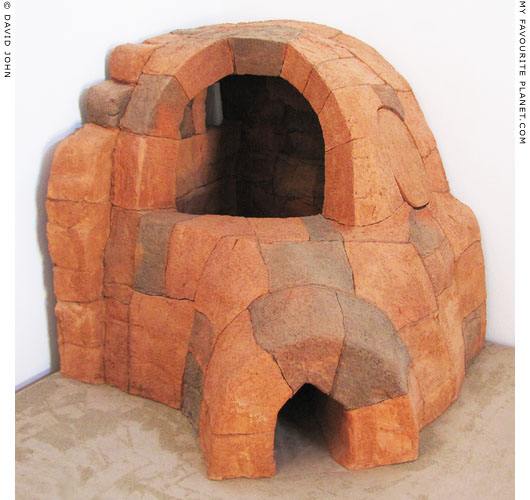
A reconstruction of a pottery kiln of the Middle Bronze Age
(Middle Helladic, 2000-1600 BC) from Aegina, Greece.
The model is a copy of a well-preserved original discovered in the 1980s during
archaeological excavations by the University of Salzburg, in the inner extension
built at the corner of House 7, in ancient Aegina Kolonna, Town IX, 1800-1650 BC.
Ceramics found at the Cape Kolonna site date back to the Late Stone Age (Neolithic,
5th millenium BC, Town I). Early wheel-made pottery found here dates from around
the end of the Early Bronze Age (Early Helladic III, Town V, 2200-2100 BC).
Model by the Austrian ceramic artist Günter Praschak (1940-2015)
who worked with the archaeologists at Kolonna.
Aegina Archaeological Museum. |
| |
Potters and
vase painters |
B |
|
 |
|
| |
Berlin Painter
Red-figure vase painter in Athens,
active around 505-460 BC.
Admired for his refined, elegant style, he is considered as one of the finest vase painters of the early 5th century BC, alongside the Kleophrades Painter. He is credited as the creator of over 300 works.
He began career in the workshop of the Pioneer Group (the Dikaios Painter, Euphronios, Euthymides, Hypsias, Phintias, Smikros and the Sosias Painter), which adopted the red-figure technique developed by earlier painters such as Andokides and Psiax.
He was the teacher of the Achilles Painter and Hermonax.
None of the Berlin Painter's works are signed. He was named by John Beazley after a large lidded red-figure amphora (his name vase) in the Berlin State Museums (SMB). Inv. No. F 2160. Side A shows a satyr, Hermes and a fawn. Side B shows a satyr.
He began his career working in the Late Archaic style, and made a number of black-figure Panathenaic amphorae. He was one of the vase painters who developed the Classical Attic red-figure style.
An Attic red-figure pelike with a Dionysus followed by a satyr carrying a tripod, 480-470 BC, attributed to the Berlin Painter. National Archaeological Museum, Paestum, Campania, Italy. |
|
|
| |
Boreas Painter
Red-figure vase painter in Athens,
active around 470-460 BC.
Named the Boreas Painter by Sir John Beazley due to a number of vases attributed to him depicting Boreas (god of the North Wind). A number of other vase paintings, mostly on kraters, have been attributed to him on the basis of style. His style is close to that of the Florence Painter and the Painter of London E489.
An Attic red-figure column krater found in Akragas (Agrigento), Sicily, depicting a a god chasing a female, possibly Plouton (Hades) and Persephone, or Zeus and a maiden, has been attributed to the Boreas Painter. The other side shows a female figure with a torch. Around 470-460 BC. Antonino Salinas Regional Archaeological Museum, Palermo. Inv. No. V795.
Beazley Archive Database, Vase No. 206127 |
|
|
| |
Brygos
Βρύγος
Potter, and perhaps painter, in Athens, active around 500-450 BC.
Thought to be from western Macedonia, based on the letter-forms of his signature.
Brygos was named by Sir John Beazley after the signature Βρυγος εποιεσεν (Brygos epoiesen, Brygos made it) on a number of Attic red-figure vases.
His workshop produced high quality wares, mostly drinking cups, but also other types of vessels such as rhytons (drinking horns) in the shape of animal heads.
He employed a number of painters, including the Briseis Painter, the Foundry Painter and the Brygos Painter. Some scholars believe that Brygos and the Brygos Painter may have been the same person. |
|
|
| |
Brygos Painter
Red-figure vase painter, and perhaps potter, in Athens, active around 500-450 BC. Thought to have been particularly active around 480-470 BC.
Perhaps a pupil of Onesimos, with whom his works have been compared.
Thought to have worked in the workshop of the potter Brygos, he was named by Sir John Beazley after the signature Βρυγος εποιεσεν (Brygos epoiesen, Brygos made it) on a number of Attic red-figure vases with paintings attributed to the same artist. The signature is thought to be that of Brygos as potter, but some scholars believe that the potter and painter may have been the same person.
The Brygos Painter is considered, along with Douris (see below), Makron and Onesimos, one of the finest and most influential vase painters of the period. He was prolific, and over 200 vessels have been attributed to him, several signed by Brygos. Most of the surviving paintings are on kylikes (types B and C), but he also painted skyphoi, kantharoi, rhyta and lekythoi, as well as some white-ground vases.
A burnt fragment of a plate with a depiction of a reveller, attributed to the Brygos Painter, was found by archaeologists on the Athens Acropolis among the "Perserschutt", deposits of rubble from the Persian destruction of 480 BC. This has been taken as evidence that he was working before this date. His works have also been discovered at other archaeological sites in Greece and Italy.
He painted mythological scenes, particularly Homeric themes and Achilles, as well as genre scenes, including symposia and athletes. The depictions are innovative in style and technique, and he often experimented with spatial effects, settings and washes. His drawing style is elegant, usually with fine, clear contours, and he has been praised for the poses and details of his figures, particularly the well-observed, expressive faces, and the lively interaction between characters. In some cases the names of the characters are inscribed.
He is also credited with a painting of Alkaios and Sappho on an Attic red-figure kalathos (wine mixing vessel), dated around 470 BC, now in the Glyptothek, Munich (see photos below).
Some paintings thought to be his later works are considered to be of poorer quality. Beazley commented that a painting on a kylix now in Milan (see photo below) was "late and especially poor", although other scholars consider even his poorer work was superior to that of many of his contemporaries.
He is best known for the "Iliupersis Cup" or "Brygos Cup", a red-figure kylix signed by Brygos on a handle, depicting the Ilioupersis (Ἰλίου πέρσις, Iliou persis, Sack of Ilium, usually referred to as the Sack of Troy). Circa 480-475 BC. Excavated at Vulci, Etruria. Louvre Museum, Paris. Inv. No. G 152. See: www.louvre.fr/... |
|
|
| |
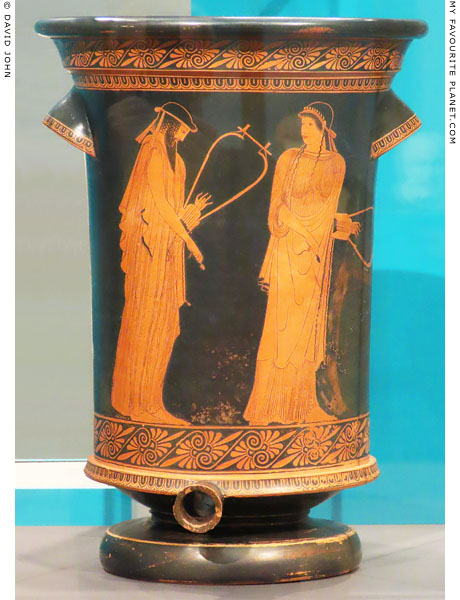
An Attic red-figure kalathos (wine mixing vessel) with a depiction of the
Lesbian poets Alkaios and Sappho, each holding a lyre and a plectrum.
Their names are inscribed to the right of Alkaios' head (see photo below).
Made in Athens around 470 BC. Attributed to the Brygos Painter.
Staatliche Antikensammlungen und Glyptothek, Munich. Inv. No. SH 2416. |
| |
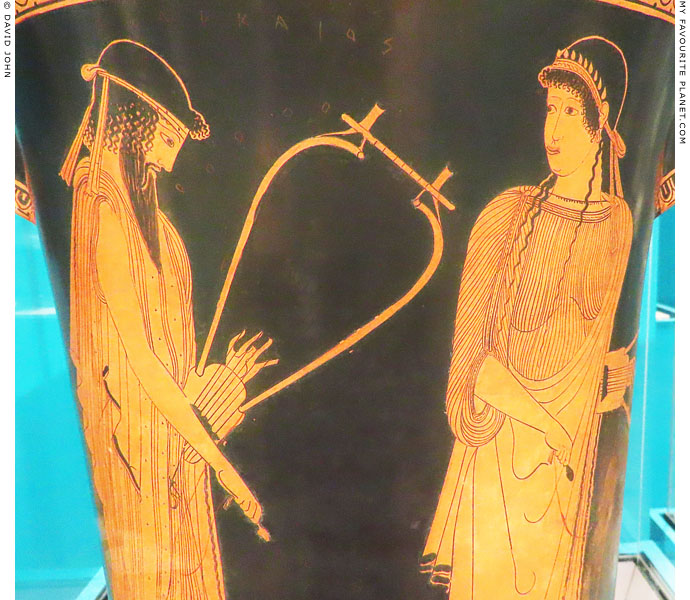
Detail of Alkaios and Sappho on the kalathos by the Brygos Painter in Munich. |
| |

The tondo of an Attic red-figure kylix (wine cup) with a painting of a young woman, wearing
a long chiton (tunic), holding a stiula (bucket) in her left hand and the rope of a well in the right.
Below the situla is a pithos (large storage jar), used as a water tank, half buried in the ground.
The word ΚΑΛΕ (KALE, good, beautiful) is inscribed on the situla and vertically on the background,
left of the figure. The sides of the cup are undecorated.
Made in Athens, 490-480 BC. Attributed to the Brygos Painter
by Sir John Beazley. Provenance unknown.
Greek section, Civic Archaeological Museum, Milan.
Inv. No. A 0.9.266. From the Seletti Collection. |
| |
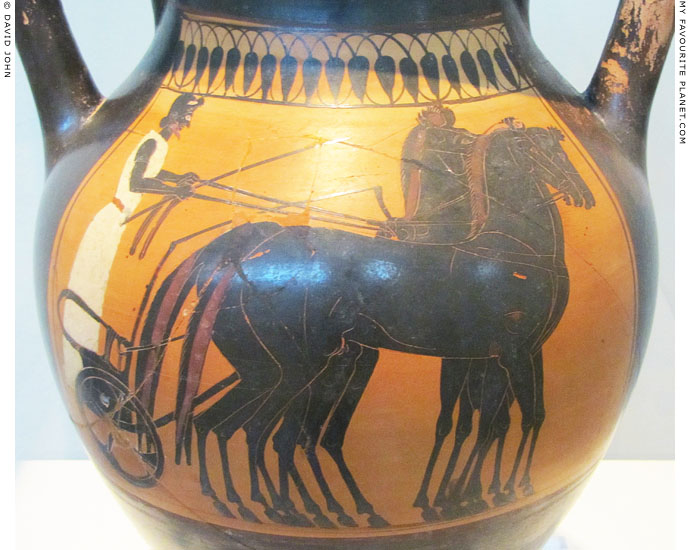
Detail of an Attic black-figure amphora with a depiction of a quadriga (four-horse
chariot) painted on both sides. Here the charioteer waits for the start of a race.
Around 510 BC. Painting by the Painter of Bologna 48. Found on Rhodes.
National Archaeological Museum, Athens. Inv. No. 12716. |
| |
Potters and
vase painters |
C |
|
 |
|
| |
Choregos Painter
Red-figure vase painter in Apulia, Magna Graecia (southern Italy), perhaps in Metapontion (Μεταπόντιον) on the gulf of Tarentum, active around 400-370 BC.
The few vase paintings attributed to the Choregos Painter depict theatrical scenes. Named by Arthur Dale Trendall (1909-1995) after "the Choregos vase" (or "the Choregoi vase"), an Apulian red-figure bell krater, 400-380 BC, with a scene from a Phlyax play depicting Aegisthos, two choregoi and Pyrrhias. Formerly in the J. Paul Getty Museum, Los Angeles. Inv. No. 96.AE.29. Returned to Italy in accordance with agreements of 2007 concerning looted artworks.
"The Krater of the Gluttons" (see photos below) is also attributed to the Choregos Painter. An Apulian red-figure bell krater, 380-370 BC, excavated in 1883 at Ruvo di Puglia (Bari), southern Italy. Side A depicts a theatrical scene from a Phlyax farce, with the inscribed names of three characters. Side B shows a parody of the myth of Herakles holding up the heavens in the place of Atlas. Civic Archaeological Museum, Milan. Inv. No. A 0.9.2841. |
|
|
| |
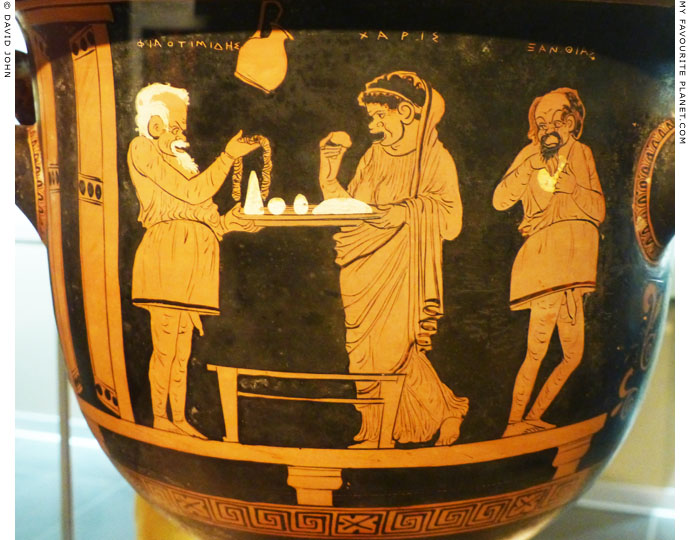
Detail of Side A of the "Krater of the Gluttons", an Apulian red-figure bell krater, with
a depiction of a theatrical scene from a Phlyax farce. See the painting on Side B below.
Around 380-370 BC. Attributed to the Choregos Painter by Arthur Dale Trendall. Discovered
in April 1883 at Ruvo di Puglia (Bari), southern Italy during excavations by Francesco Caputi
Iambrenghi (owner of the well-known Caputi Collection of vases begun by his uncle, archdeacon
Giuseppe Caputi around 1830) *. Height 32.5 cm, maximum diameter 36.5 cm.
Civic Archaeological Museum, Milan. Inv. No. A 0.9.2841. Donated by Athos Moretti.
|
"The Krater of the Gluttons" (Italian, "il Cratere dei Ghiottoni") is also known as "the Milan Cake-eaters", "the Stealers of dainties" and "the Eaters of dainties". The painting on Side A depicts a scene from a Phlyax play (Φλύαξ, also Phlyakes, Gossip Players), a type of burlesque or farce developed during the 4th century BC in the Greek colonies in Magna Graecia (southern Italy). Only some titles and a few fragments of the plays have survived, as well as the names of five of the genre's playwrights. Paintings on several surviving vases from southern Italy are thought to represent scenes from such plays. They appear to show mythological figures and stock characters and situations of the Attic New Comedy.
This scene takes place on a stage supported by three columns, with a partly open double doorway on the far left. An oenochoe (wine jug) hangs on the back wall. Three masked characters, their names painted above their heads, stand around a low table. On the left, the white-haired Philotimides (variously translated as Son of Ambition, Lover of Honour, Magnificent or Greedy), facing right with what appears to be a string of sausages in his raised right hand, holds a tray of food with the woman Charis (Xaris, Grace), who faces him with a cake in her right hand. On the right, Xanthias (Blondie) appears to be creeping off, hiding a stolen cake in his tunic. The identities of the characters their relationships to each other are unknown. It has been suggested that Philotimides and Charis are the master and mistress of the house, while Xanthias is a slave, although both males wear identical costumes.
* Heinrich Heydemann, Vase caputi mit Theaterdarstellungen. Hallisches Winckelmannsprogramm, Band 9. Max Niemeyer, Halle/Saale, 1884. At Heidelberg University Digital Library. |
|
|
| |
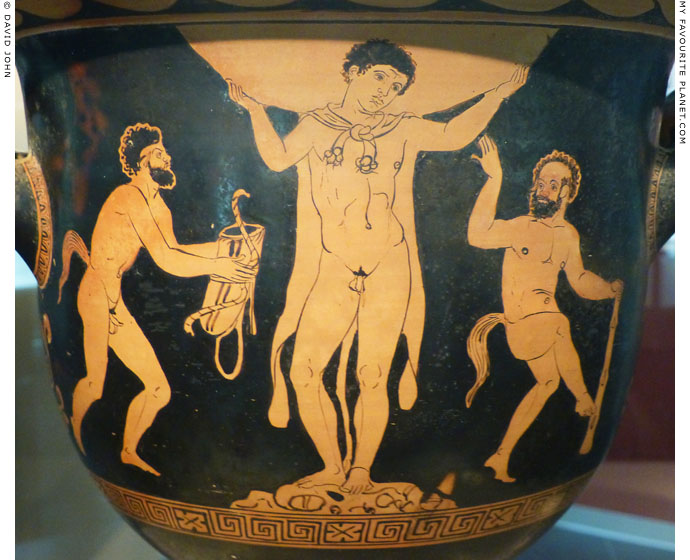
Detail of Side B of the "Krater of the Gluttons", attributed to the Choregos Painter, depicting
a parody of a youthful Herakles, wearing the skin of the Nemean Lion, supporting the heavens
in the place of Atlas. Two Satyrs, taking advantage of his situation, steal his club, bow, arrows
and quiver. Thought to be a scene from a comedy performance. |
| |
Christie Painter
Red-figure vase painter in Athens, active around 450-420 BC.
He was named by John Beazley after one of his vases in the Christie collection.
An Attic red-figure pelike with a Dionysiac scene, 450-425 BC, attributed to the Christie Painter. Paolo Orsi Regional Archaeological Museum, Syracuse. Inv. No. 35188.
An Attic red-figure hydria attributed to the Christie Painter, 430-420 BC. Used as a funerary ash container. From ancient Abdera, Thrace (see below). |
|
|
| |
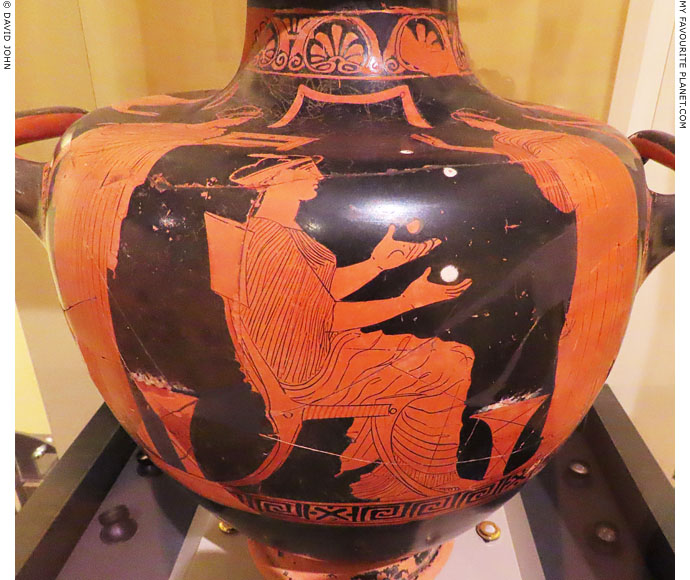
Detail of an Attic red-figure hydria attributed to the Christie Painter. A young woman
wearing a peplos, seated on a chair and facing right, juggles four balls. Two other
young women stand on either side of her. The woman immediately to her left holds
up a box in her left hand. The other side of the vase is not decorated. The black lid
of the vessel is also displayed.
430-420 BC. From ancient Abdera, Thrace, northeastern Greece.
The vase was used in a burial to contain the ashes of a deceased person.
Abdera Archaeological Museum. Inv. No. MA 5982.
The vase was found by a local person and handed over to the authorities in 1963. |
| |
Cock Group
(Gruppo del Gallo)
A group of black-figure vase painters working in Athens around 525-501 BC.
An Attic black-figure lekythos (oinment jar) with a depiction of Dionysus dancing with two satyrs. On the shoulder is a cockerel between two heart-shaped leaves. Attributed to the Cock Group by Italian archaeologist Claudia Lambrugo. Late 6th - early 5th century BC. Civic Archaeological Museum, Milan. Inv. No. A 0.9.148. |
|
|
| |
Potters and
vase painters |
D |
|
 |
|
| |
Darius Painter
Vase painter of the red-figure technique, in Apulia, southeast Italy, active around 340-320 BC.
Considered one of the greatest and most prolific Apulian vase painters. He may have been the owner or foreman of a large workshop, perhaps at Taras (Taranto) or Canosa (Canosa di Puglia), Apulia, southeast Italy. It has recently been suggested that he and other contemporary vase painters may have worked elsewhere, perhaps in Lucania (Basilicata).
He was named by Arthur Dale Trendall (1909-1995) after the "Darius vase" (his name vase, also known as the "Persian vase"), a large volute krater (height 130 cm, diameter 60 cm) discovered in 1851 near Canosa di Puglia. Now in the National Archaeological Museum, Naples. Inv. No. 81947 (H 3253).
None of his works are signed, but many feature inscriptions with the names of historical and mythical figures and subjects depicted in scenes taken from history, myths and the Classical theatre, particularly the tragedies of Euripides. Some paintings show scenes not known from other surviving artworks. He mostly painted large vases, including volute kraters, amphorae and loutrophoroi. He also painted Dionysian motifs, erotes, wedding scenes and women, particularly on pelikes. His draughtsmanship and compositions are bold and colourful, although not usually very dramatic. On the larger vases, a number of scenes are depicted on several registers.
A large number of works attributed to the Darius Painter are now in collections and museums around the world.
A fragment of an Apulian red-figure volute krater shows a scene from a Gigantomachy, with Athena fighting the giant Enkelados. Museum für Kunst und Gewerbe Hamburg. Inv. No. 2010.18. |
|
|
| |
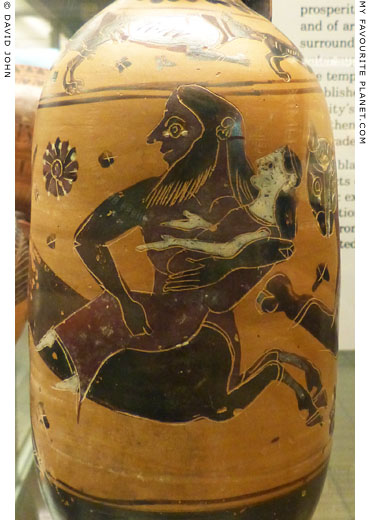
The Centaur Nessos abducting Deianeira, the wife of Herakles.
Detail of an Attic black-figure lekythos (oil or perfume
flask). Made in Athens around 600-580 BC. Attributed to the
Deianeira Painter, who is named after this vase. From Corinth.
Nessos, with Deianeira in his arms, gallops to the right,
looks back to the left to see Herakles (on the other side
of the vessel) chasing him. The scene is echoed by the
dogs chasing a hare on the shoulder of the flask.
British Museum. Inv. No. 1883.1-4.1 (Vase B 30).
See also: Herakles fighting Nessos on the "Nessos Vase",
painted circa 620-610 BC by the Nessos Painter. |
| |
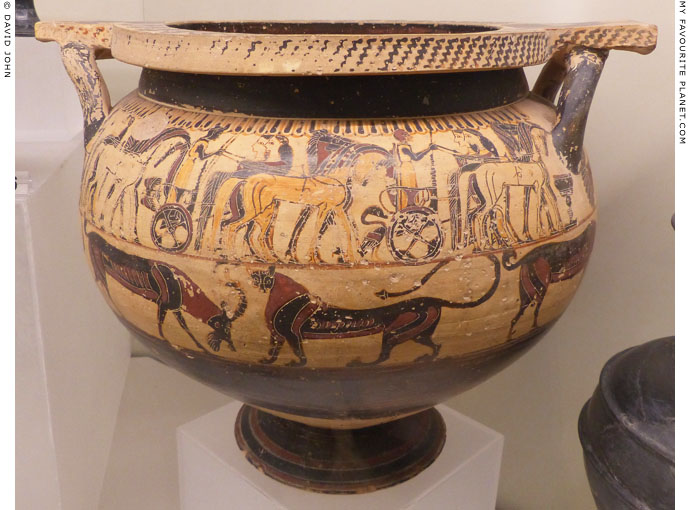
Corinthian column krater with a depiction of a procession of three-horse chariots.
The foremost horses are of a light colour, those behind dark red and black. Behind
the horses of each of the three chariots two female figures stand close together.
In front of the chariots (left to right): a hawk or eagle; a large water bird (a swan?);
a vessel on a stand. In the register below a lion stands between two antelopes.
Attributed to the Detroit Painter, 600-580 BC. Excavated in 1917 at
Tomb II, Banditaccia necropolis, Cerveteri (ancient Caere, Etruria).
National Etruscan Museum, Villa Giulia, Rome. |
| |
Diphilos
Δίφιλος
The owner of a pottery workshop in Myrina, Mysia (northwestern Anatolia), known from several signed terracotta figurines.
Late 1st century BC - early 1st century AD
A terracotta figurine of Herakles, found in the Myrina necropolis, signed on the back by Diphilos. Berlin State Museums (SMB). Inv. No. TC 8154. |
|
|
| |
Dodwell Painter
Black-figure vase painter in Corinth,
active around 600-570 BC
One of the most important and influential vase painters of the Middle and Late Corinthian periods (circa 600-550 BC).
He painted friezes of animals, horsemen and mythological figures, mainly on oinochoai and pyxides, but also on neck amphorae and hydriai.
Around 70 vases have been attributed to the Dodwell Painter. He is named after the "Dodwell Pyxis", an inscribed Middle Corinthian convex pyxis, around 590 BC, once owned by the Irish writer and painter Edward Dodwell (1767-1832), who purchased it in 1806 near Corinth, and kept it in his private museum of antiquities in Rome. It was later purchased with other objects from Dodwell's collection on behalf of Ludwig I of Bavaria, and is now in the Staatliche Antikensammlungen, Munich. Inv. No. 47.
On the lid of the pyxis is a depiction of the Kalydonian Boar hunt as well as other unconnected mythological figures, including Agamemnon. The figures are named by inscriptions, although not all appear to match the respective figure.
Other significant examples of his work include an olpe (jug) in the National Etruscan Museum, Villa Giulia, Rome, with a frieze depicting komasts dacing around a krater, and vases in the Saint Louis Art Museum, Inv. No. 174.1924, and the Martin von Wagner Museum, University of Würzburg, Inv. No. L 120.
A Corinthian black-figure olpe (jug), early 6th century BC, now in Milan is also attributed to the Dodwell Painter (see photos below). Civic Archaeological Museum, Milan. Inv. No. A 0.9.21532. |
|
|
| |
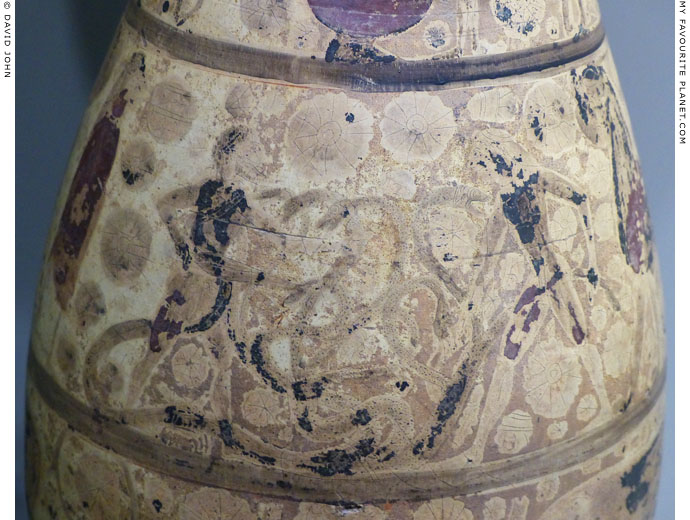
Detail of a Middle Corinthian black-figure olpe (ὀλπή, wine jug) with a depiction of Herakles and
his nephew Iolaos (Ἰόλαος) fighting the Lernaian Hydra (Λερναῖα Ὕδρα), watched by Athena.
First decades of the 6th century BC. Attributed to the Dodwell Painter.
Greek section, Civic Archaeological Museum, Milan. Inv. No. A 0.9.21532.
|
The olpe is painted with three friezes in horizontal bands (see photo right). The top band shows dancers wearing padded costumes in erotic scenes. In the middle Herakles and Iolaos fight the Lernaian Hydra, watched by Athena. In the bottom band is a frieze of animals. Spaces around all the figures are filled by rosettes of different sizes.
On other paintings of the Dodwell Painter the drawing is bold and the colours deep purples and blacks, typical of Middle Corinthian vases. Unfortunately, the colours on this olpa have not survived well, although the incised contours, roughly drawn by the artist on the unfired clay before painting, can still be seen. |
|
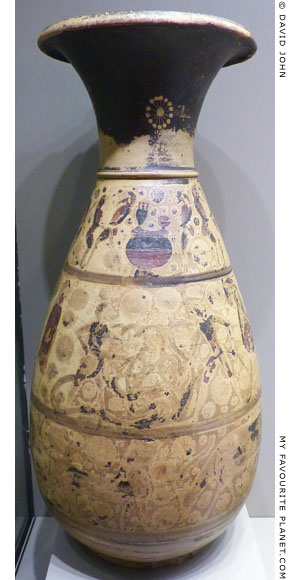
The Corinthian olpe by the
Dodwell Painter in Milan. |
|
| |
Dolon Painter
Red-figure vase painter in Lucania (Basilicata), southeast Italy, active around 390-380 BC.
He was part of the second generation of vase painters in the workshop at Metapontion (Μεταπόντιον) on the gulf of Tarentum, established by the Pisticci Painter and the Amykos Painter. His work was close to that of Apulian vase painters of the "Plain" style, and particularly close to the Tarporley Painter, with whom he may have worked.
He was named by Arthur Dale Trendall (1909-1995) after a red-figure calyx krater, circa 390-380 BC, depicting Odysseus and Diomedes ambushing the Trojan spy Dolon (his name vase). British Museum. GR 1846.9-25.3 (Vase F157).
Several vases have been attributed to the Dolon Painter on the basis of style. He often painted mythological subjects. |
|
|
| |
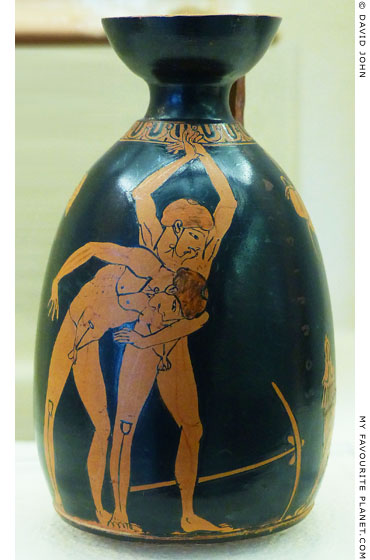
A "Columbus" type aryballos (ἀρύβαλλος; plural aryballoi,
ἀρύβαλλοι; small globular flask for perfume, ointment or
oil) with a red-figure painting of two young wrestlers
training. To the left and right of the figures are the
inscriptions ΧΑΙΡΙΠΠΟΣ ΚΑΛΟΣ (Chairippos is beautiful)
and ΘΩΔΙΣ ΚΑΛΟΣ (Thodis is beautiful), so-called
kalos inscriptions.
Around 490-480 BC. Attributed to the workshop of the
painter Douris. Found in a tomb in Kerameikos, Athens.
Kerameikos Archaeological Museum. |
| |
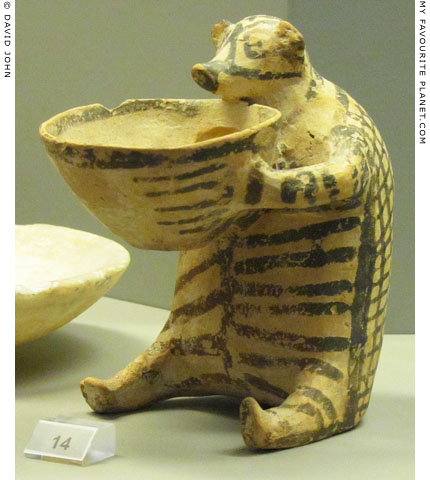
A moulded, painted zoomorphic ceramic vase in the form of a sitting
hedgehog. Liquid poured into the deep bowl the animal holds with
both front paws would disappear through an opening into its hollow
body, and it would appear that it had drunk it.
A grave offering from Chalandriani on the Cycladic island of Syros.
Early Cycladic II period, Keros-Syros culture, around 2800-2300 BC.
National Archaeological Museum, Athens. Inv. No. P6176.
See also a ceramic kernos of the same period
from Syros in Demeter and Persephone part 1. |
| |
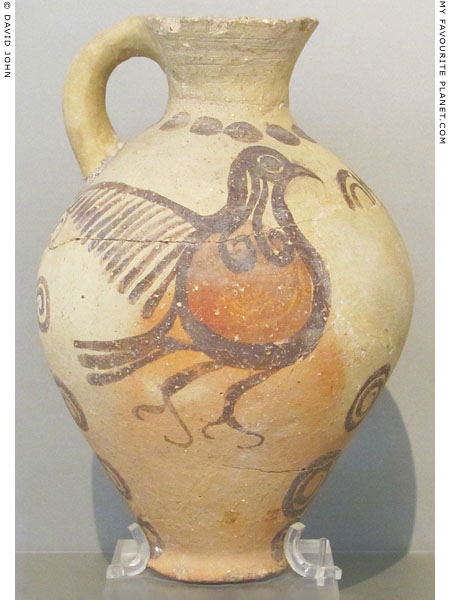
Ceramic jug with a bird on either side, painted
in the typical Cycladic "black and red" style.
From Phylakopi on the Cycladic island of Melos.
Middle Cycladic - Late Cycladic I period, around 1600 BC.
National Archaeological Museum, Athens. Inv. No. 5762. |
| |
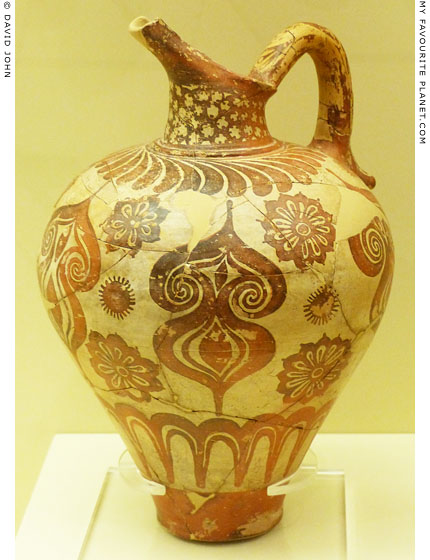
A Mycenaean bridge-spouted jug with Minoan influence.
From Tomb 518, Kalkani, Mycenae.
Late Helladic II period (LH IIA), around 1500-1450 BC.
Mycenae Archaeological Museum. Inv. No. MM 1042. |
| |
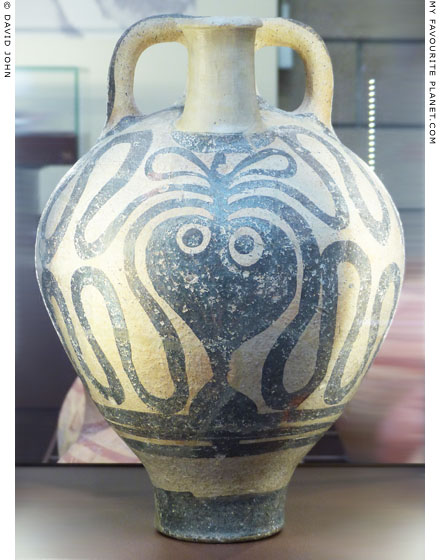
A Cretan stirrup jar with an octopus painted on both sides.
Made in western Crete, 14th - 13th century BC. Found
in the Palace of Thebes. Boeotia, central Greece.
Thebes Archaeological Museum. |
| |
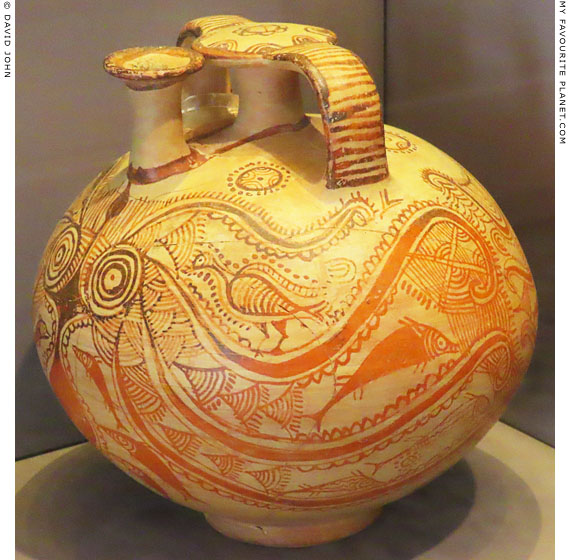
A stirrup jar with an octopus painted on both sides. The cream-coloured body
of the vessel is crowded with imagery painted in dark brown, fading in places
to red-brown. Each octopus has two frontal eyes represented by concentric
circles, and eight long wavy arms, between which fish swim. On the side
shown in the photo a bird stands on one of the arms.
Middle Bronze Age (Late Helladic IIIC, 1365-1180 BC).
From Kos, Dodecanese, Greece.
Kos Archaeological Museum. |
| |
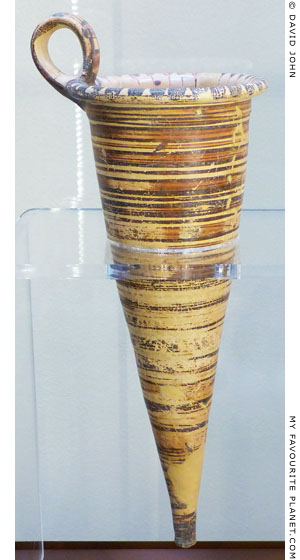
A ceramic rhyton (drinking horn)
from the cemetery of Kallithea,
Boeotia, central Greece.
14th century BC.
Thebes Archaeological Museum. |
|
|
|
| |
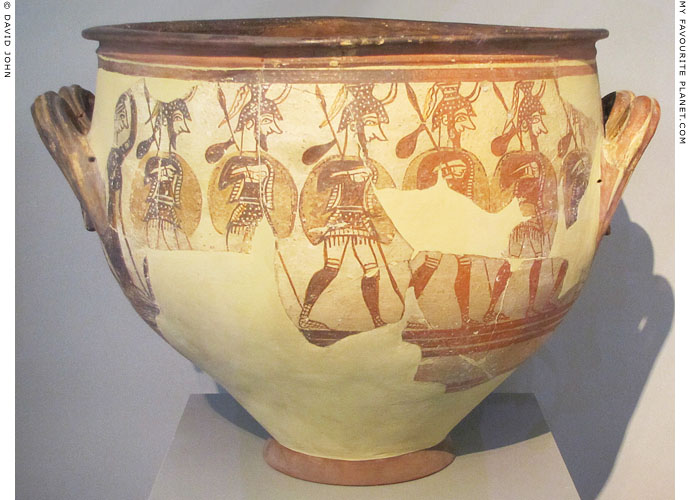
The "Warrior Vase", a large Mycenaean krater with a depiction of six warriors in full
armour (helmet, cuirass, greaves, shield and spear) departing for war. Each has a sack
of supplies hanging from his spear. On the far left a woman raises her hand, either in
farewell or a mourning gesture. On the other side of the krater are another five warriors,
dressed similarly but with different helmets, raising their spears. The handles are
decorated with reliefs of bovine heads, below which are painted birds and animals.
12th century BC, Late Helladic III period (LH IIIC). Excavated in the "House of
the Warrior Vase", Mycenae acropolis, Peloponnese, Greece. Height 41 cm.
National Archaeological Museum, Athens. Inv. No. 1426. |
| |
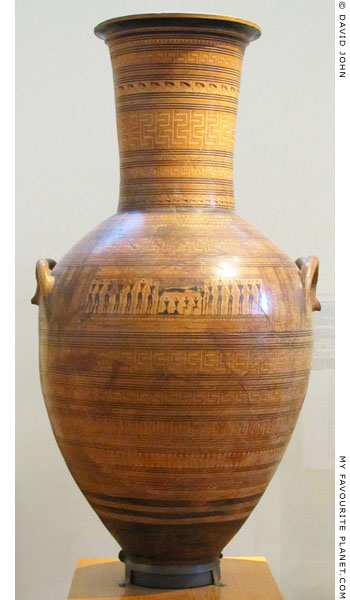
The "Dipylon Amphora" (or "Dipylon Vase"), the name vase
of the Dipylon Painter, also referred to as the Dipylon Master.
A monumental grave amphora, painted with a mourning
scene (see detail below), animal friezes on the neck,
and otherwise covered by bands of geometric motifs.
Late Geometric period, around 760-750 BC. From the cemetery
near the Dipylon Gate, Kerameikos, Athens. Height 155 cm.
National Archaeological Museum, Athens. Inv. No. 804. |
| |
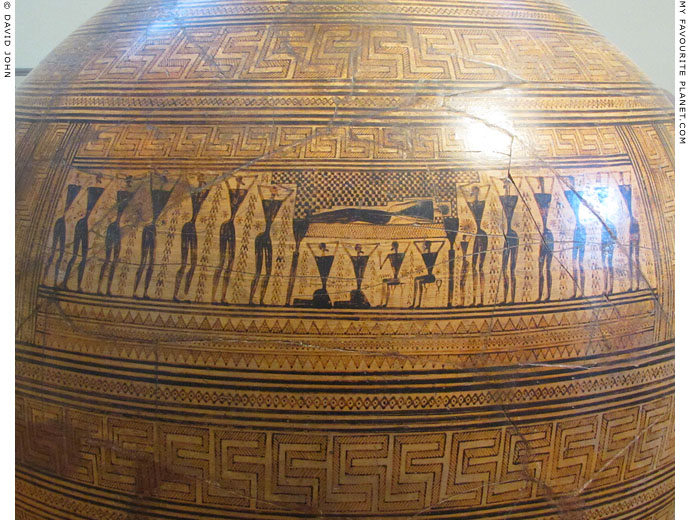
The mourning scene by the Dipylon Painter on the grave amphora above.
The main scene shows the prosthesis (laying out of the corpse) and mourning
for the deceased who lies on a bier covered by a shroud. Below the bier are
four figures, two kneeling and two sitting. The men, women and children
have their hands on their heads, a usual mourning gesture. |
| |
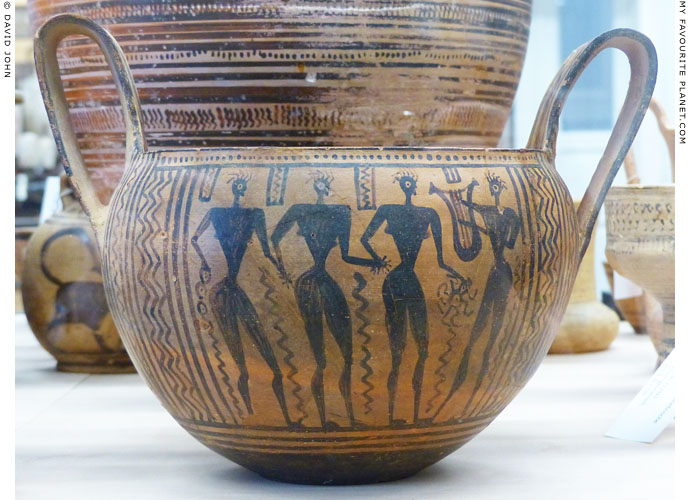
Late Geometric Boeotian kantharos (drinking cup) with a depiction of three females
with joined hands, probably dancing, and a fourth (male?) figure playing a lyre.
The painting has been interpreted as representing a choral performance or Apollo
and the Muses. It has been suggested that the female on the right is holding
a wreath. On the other side are two boxers between two figures with swords.
Late 8th century BC. Height 14.9 cm.
Studiendepot, Skulpturensammlung, Albertinum, Dresden. No. ZV 1699. |
| |
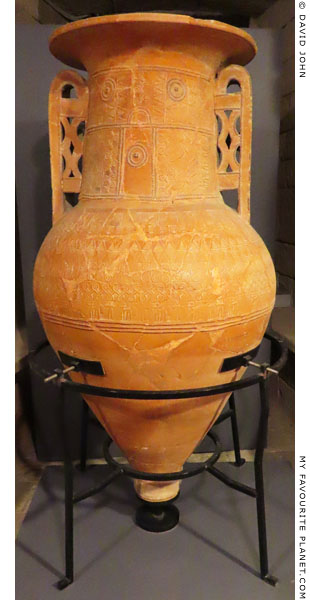 |
|
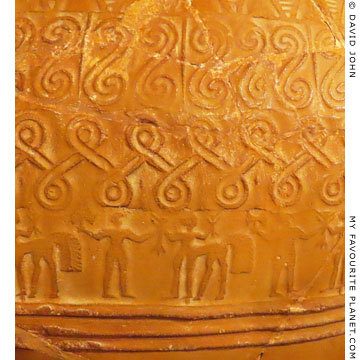 |
A large Archaic relief pithos from Rhodes, crudely decorated around the neck and shoulder
with stamped areas and bands of repeated abstract geometric motifs and rows of figures,
alternately a Centaur and male figure holding a double axe and a lightning bolt, thought
to represent Zeus Labraundos (Ζευς Λαβραυνδος or Λαβρανδευς).
6th century BC. Found in the necropolis at Macri Langoni near the ancient city
of Kamiros, western Rhodes. It had been used for the burial of a child.
Rhodes Archaeological Museum.
Currently (2022) part of the extended exhibition "Ancient Rhodes - 2400 years"
in the Palace of the Grand Master, Rhodes.
Several similar pithoi have been found on Rhodes, and some are kept in a storeroom in front
of the Rhodes Archaeological Museum. This is open to the public only on Sundays. Apparently
they have never been published, and therefore photography is not allowed in the storeroom.
Another similar pithos with more sophisticated figurative decoration, featuring of the Trojan
horse and scenes of the sacking of Troy, made on the Cycladic island Tenos (modern Tinos)
around 675-650 BC, is now in the Mykonos Archaeological Museum (see Homer part 3). |
|
| |
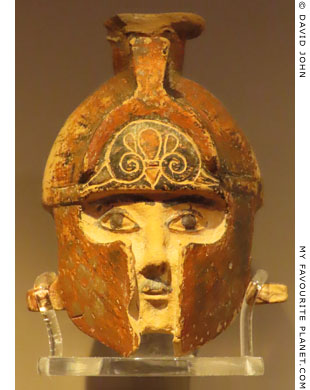
A Rhodian aryballos (ἀρύβαλλος, small
globular flask for perfume, ointment or oil)
in the form of the head of a helmeted
warrior (often referred to as a hoplite).
This design type seems to have been
popular, and several such vases can
today be seen in the world's museums.
Late 7th - 6th century BC. Found along
with a large number of votive offerings in
a rural sanctuary in the Irakles (Herakles)
area of Psalidi, Kos, Dodecanese.
Kos Archaeological Museum. |
|
|
| |
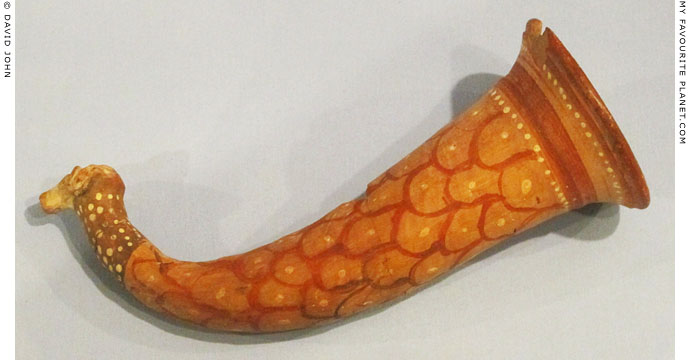
A ceramic rhyton (drinking horn).
6th century BC. From the Archaic city Old Smyrna
(Eski Izmir), Bayraklı, Izmir, western Turkey.
Izmir Archaeological Museum. |
| |
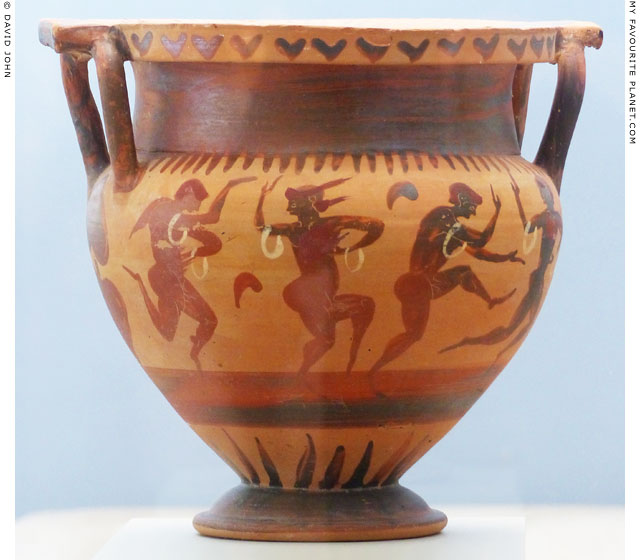
A black-figure column krater from Eion, near Amphipolis, Macedonia. Made in a local workshop
in imitation of Attic pottery. Late 6th century BC. On Side A a painting of a group of komasts
(κωμαστές, revellers) dancing after a symposium. On Side B two opposing lions.
Amphipolis Archaeological Museum. Inv. No. M.A. 1351. |
| |
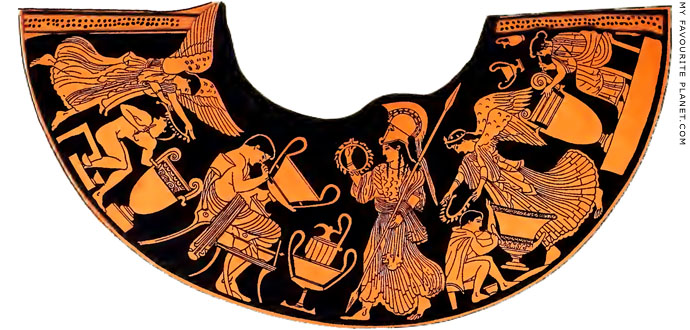
The workshop of a vase painter. A drawing of the red-figure painting on a hydria in the Caputi
Collection, Ruvo, Italy. Three men and a woman (on a platform, far right) sit and and paint large
vases (2 volute kraters, a kantharos and a calyx krater). An oinochoe (οἰνοχόη, wine jug) and
a kantharos stand in front of the largest male figure, perhaps the workshop master. The men
are brought wreaths by helmeted Athena and two winged Nikai.
Source: Edmond Pottier, Douris and the painters of Greek vases, Fig. 2.
John Murray, London, 1909. At the Internet Archive. Taken from Blümner,
Technologie und Terminologie der Gewerbe und Künste, ii., p. 85, Fig. 15. |
| |
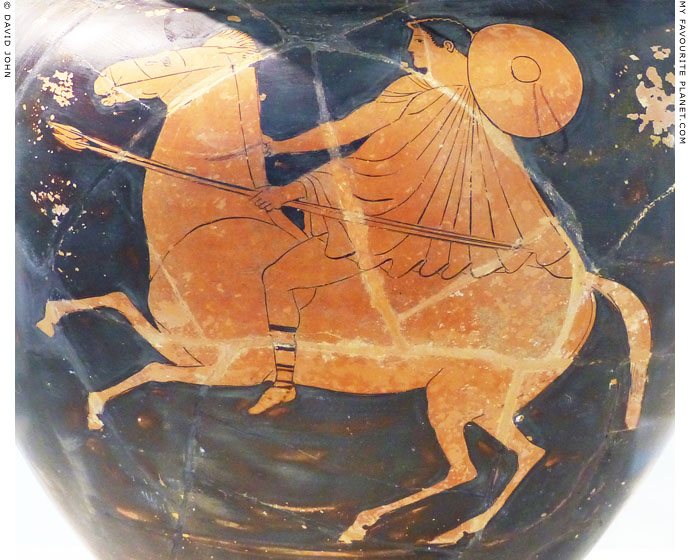
Detail of an Attic red-figure column krater with a painting of a young horseman riding
to the left. He holds the reins with his right hand, while in his left hand he carrries two
spears. He wears a chlamys (χλαμύς, a short cloak) and sandals, and behind his head
hangs a petasos (πέτασος, a broad-brimmed hat).
On Side B: a draped young man leaning on a stick.
Around 475-450 BC. Found at Argilos, Macedonia.
Amphipolis Archaeological Museum. Inv. No. M.A. 2885. |
| |
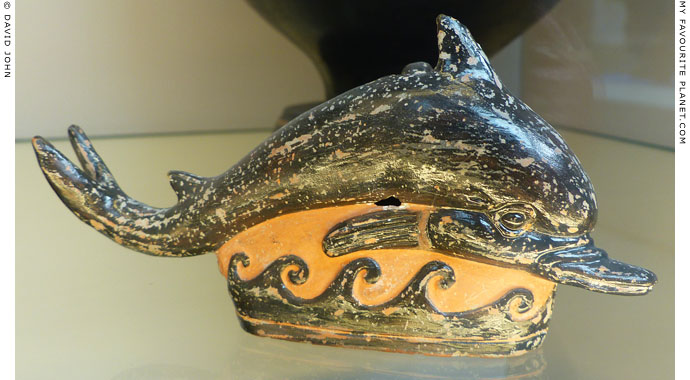
An askos (ceramic flask) in the form of a dolphin leaping over the waves,
with a ring-shaped handle on the left side (not visible in photo).
Made in Apulia, Magna Graecia (southern Italy) around 350-330 BC. Excavated at
Ruvo di Puglia (Bari), Italy. Height 9 cm, length 7.5 cm, width: 5.5 cm. weight 130 grams.
British Museum. Inv. No. GR 1856.12-26.64 (Vase G 165).
From the collection bequeathed by Sir William Temple to the museum in 1856. |
| |
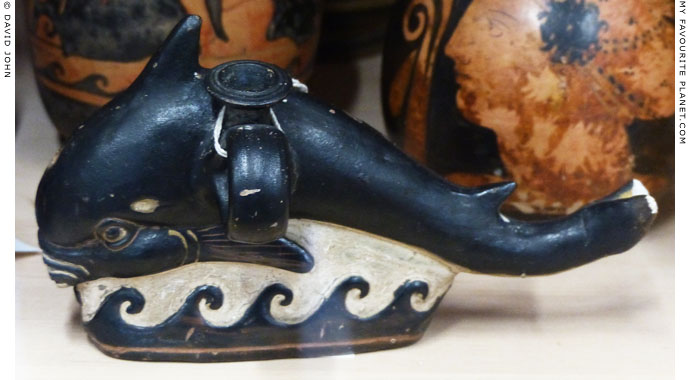
An askos in the form of a dolphin leaping over the waves,
with a ring-shaped handle on the left side. Beneath the base
is the Greek inscription ΔΑΣΤΑΣ ΗΜΙ (I belong to Dastas).
Made in Apulia (Italy) around 350-330 BC. Said to be from Rutigliano (Bari), southern Italy.
Height 9.5 cm, length 17 cm, length (base) 9.1 cm, weight 181 grams, volume 0.1 litre.
Studiendepot, Skulpturensammlung, Albertinum, Dresden. Inv. No. ZV 2867.
See: Rolf Hurschmann, Corpus Vasorum Antiquorum, Deutschland, Band 76, Dresden, Staatliche
Kunstsammlungen, Skulpturensammlung, Band 1, pages 88-89, plate (3860) 54.5-7. Munich, 2003.
See also a mosaic of a dolphin from Pergamon, 5th - 6th century AD. |
| Photos and articles © David John, except where otherwise specified. |
 |
Visit the My Favourite Planet Group on Facebook.
Join the group, write a message or comment,
post photos and videos, start a discussion... |
|
|
| |
|
|
| |
| |
 |
| |
 |
| |
 |
| |
 |
| |
 |
| |
 |
| |
George Alvanos
rooms in
Kavala's historic Panagia District
Anthemiou 35,
Kavala, Greece
kavalarooms.gr
|
| |
Olive Garden Restaurant
Kastellorizo,
Greece
+30 22460 49 109
kastellorizo.de
|
| |
Papoutsis
Travel Agency
Kastellorizo,
Greece
+30 22460 49 286
greeklodgings.gr
|
| |
|